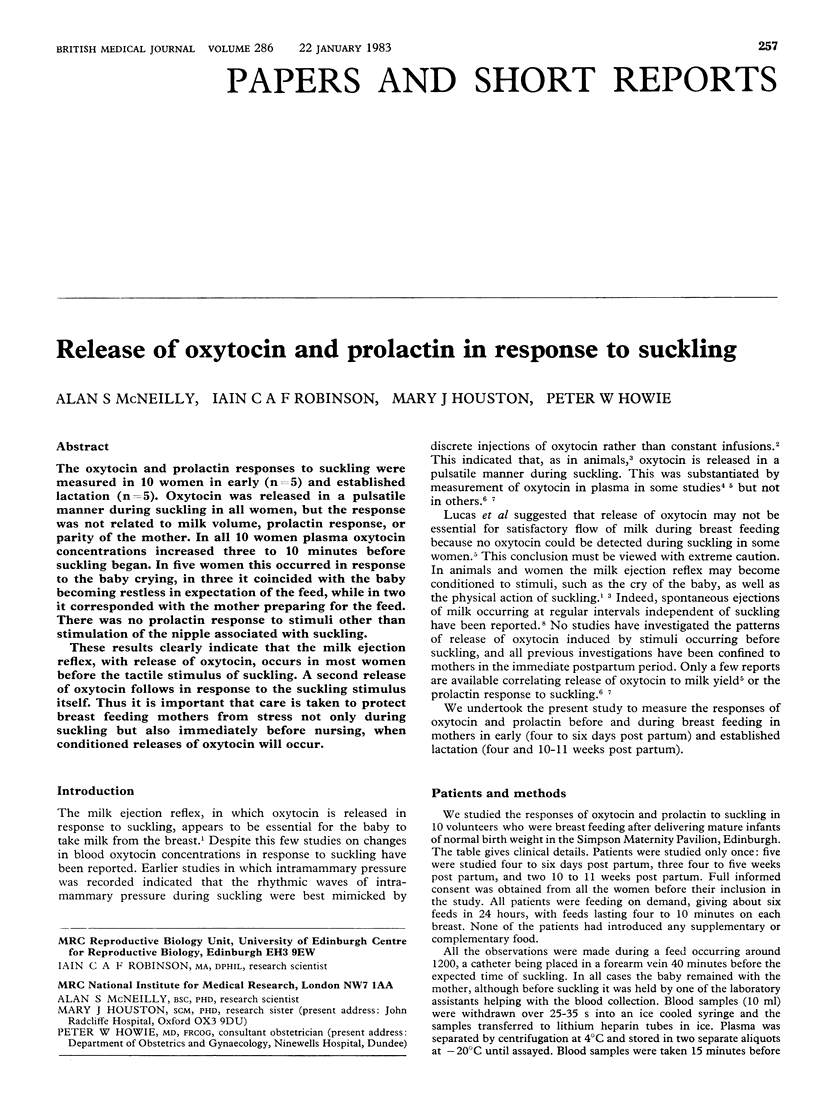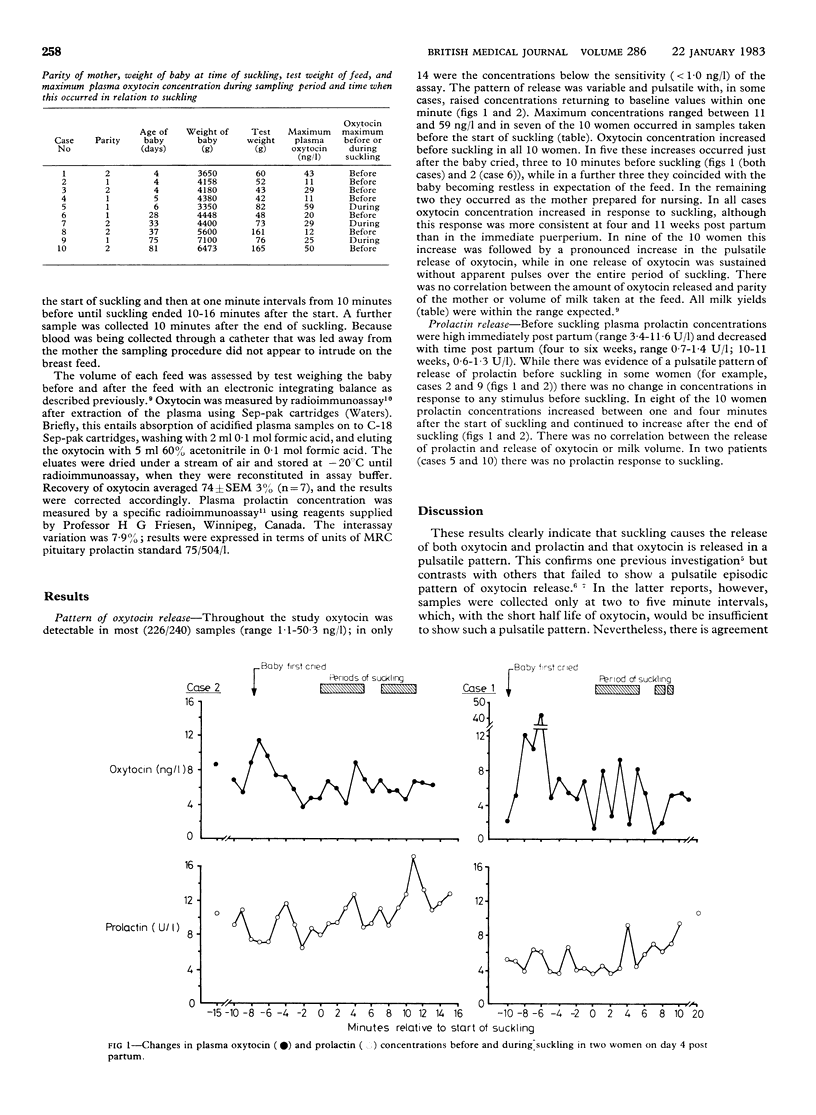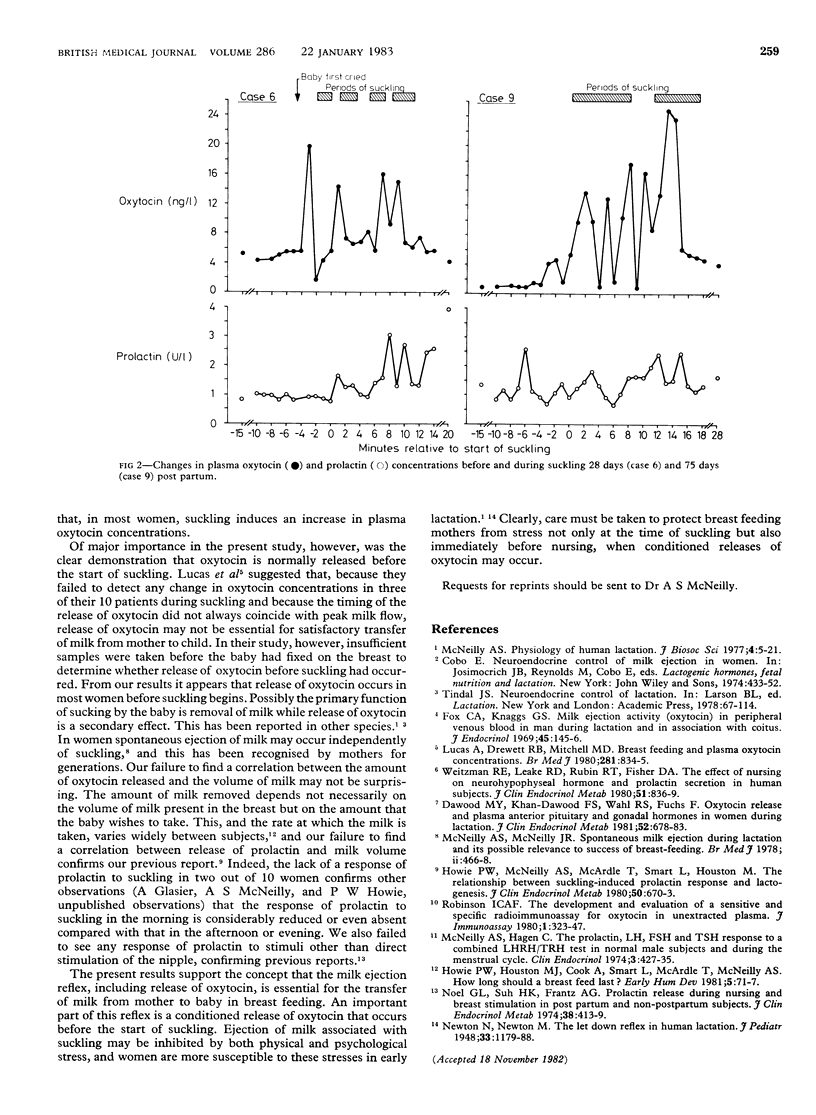Abstract
The oxytocin and prolactin responses to suckling were measured in 10 women in early (n = 5) and established lactation (n = 5). Oxytocin was released in a pulsatile manner during suckling in all women, but the response was not related to milk volume, prolactin response, or parity of the mother. In all 10 women plasma oxytocin concentrations increased three to 10 minutes before suckling began. In five women this occurred in response to the baby crying, in three it coincided with the baby becoming restless in expectation of the feed, while in two it corresponded with the mother preparing for the feed. There was no prolactin response to stimuli other than stimulation of the nipple associated with suckling. These results clearly indicate that the milk ejection reflex, with release of oxytocin, occurs in most women before the tactile stimulus of suckling. A second release of oxytocin follows in response to the suckling stimulus itself. Thus it is important that care is taken to protect breast feeding mothers from stress not only during suckling but also immediately before nursing, when conditioned releases of oxytocin will occur.
Full text
PDF


Selected References
These references are in PubMed. This may not be the complete list of references from this article.
- Dawood M. Y., Khan-Dawood F. S., Wahi R. S., Fuchs F. Oxytocin release and plasma anterior pituitary and gonadal hormones in women during lactation. J Clin Endocrinol Metab. 1981 Apr;52(4):678–683. doi: 10.1210/jcem-52-4-678. [DOI] [PubMed] [Google Scholar]
- Fox C. A., Knaggs G. S. Milk-ejection activity (oxytocin) in peripheral venous blood in man during lactation and in association with coitus. J Endocrinol. 1969 Sep;45(1):145–146. doi: 10.1677/joe.0.0450145. [DOI] [PubMed] [Google Scholar]
- Howie P. W., Houston M. J., Cook A., Smart L., McArdle T., McNeilly A. S. How long should a breast feed last? Early Hum Dev. 1981 Feb;5(1):71–77. doi: 10.1016/0378-3782(81)90072-4. [DOI] [PubMed] [Google Scholar]
- Howie P. W., McNeilly A. S., McArdle T., Smart L., Houston M. The relationship between suckling-induced prolactin response and lactogenesis. J Clin Endocrinol Metab. 1980 Apr;50(4):670–673. doi: 10.1210/jcem-50-4-670. [DOI] [PubMed] [Google Scholar]
- Lucas A., Drewett R. B., Mitchell M. D. Breast-feeding and plasma oxytocin concentrations. Br Med J. 1980 Sep 27;281(6244):834–835. doi: 10.1136/bmj.281.6244.834. [DOI] [PMC free article] [PubMed] [Google Scholar]
- McNeilly A. S., Hagen C. Prolactin, TSH, LH and FSH responses to a combined LHRH-TRH test at different stages of the menstrual cycle. Clin Endocrinol (Oxf) 1974 Oct;3(4):427–435. doi: 10.1111/j.1365-2265.1974.tb02813.x. [DOI] [PubMed] [Google Scholar]
- McNeilly A. S., McNeilly J. R. Spontaneous milk ejection during lactation and its possible relevance to success of breast-feeding. Br Med J. 1978 Aug 12;2(6135):466–468. doi: 10.1136/bmj.2.6135.466. [DOI] [PMC free article] [PubMed] [Google Scholar]
- Noel G. L., Suh H. K., Frantz A. G. Prolactin release during nursing and breast stimulation in postpartum and nonpostpartum subjects. J Clin Endocrinol Metab. 1974 Mar;38(3):413–423. doi: 10.1210/jcem-38-3-413. [DOI] [PubMed] [Google Scholar]
- Robinson I. C. The development and evaluation of a sensitive and specific radioimmunoassay for oxytocin in unextracted plasma. J Immunoassay. 1980;1(3):323–347. doi: 10.1080/01971528008058475. [DOI] [PubMed] [Google Scholar]
- Weitzman R. E., Leake R. D., Rubin R. T., Fisher D. A. The effect of nursing on neurohypophyseal hormone and prolactin secretion in human subjects. J Clin Endocrinol Metab. 1980 Oct;51(4):836–839. doi: 10.1210/jcem-51-4-836. [DOI] [PubMed] [Google Scholar]


